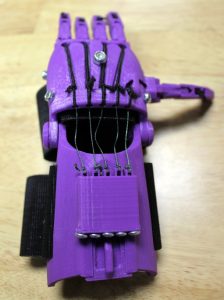Waupaca library program offers benevolent use of new tech
By Angie Landsverk

At a conference for Wisconsin’s public librarians, one of Waupaca’s librarians learned about a new use for the library’s 3D printer.
“A public librarian from Neenah was showing things you could print on a 3D printer, and then he passed around this hand,” said Emily Heideman, the teen services librarian at the Waupaca Area Public Library.
It was a prosthetic hand for a child.
He briefly mentioned it and provided links about a challenge to make more of them, she said.
The Prosthetic Kids Hand Challenge started after some sixth graders in South Carolina searched for a way to use their school’s new 3D printer.
“I think they were looking for a practical way to use the 3D printer instead of making items you throw away,” Heideman said.
They were in an Introduction to STEM (Science, Technology, Engineering, Math) class and happened to come across Enabling the Future, an organization that pairs people who need prosthetics with people who have 3D printers.
They contacted the organization and were paired with a girl who was born without a left hand.
It took the students a few attempts before they succeeded in making a hand for the girl.
They decided to take their idea further and encouraged their classmates to assemble 20 prosthetic hands in one day.
As a result, they won a 2015 Belk Service Learning Prize, which included $8,000 for them and the ability to then make more prosthetic hands and start their challenge.
At www.handchallenge.com, others are also able to become involved in making prosthetic hands for children.
The website includes tutorials about printing and assembling the parts, as well as the shipping address for the completed prosthetic hands.
The conference Heideman attended took place this past spring.
With planning underway for summer programming, she found the idea to be a good fit with year’s theme of “Build A Better World.”
“I bought some hardware to make sure it is something I could teach the kids to do,” she said. “So far, I had one workshop. I had one student put together one hand in no time.”
Next week, students will again have the opportunity to do so.
The workshop will take place from 1:30-3 p.m. Tuesday, Aug. 1, through Friday, Aug. 4, in the teen room’s makerspace.
Located in the library’s lower level, it has space for up to 10 students at a time.
The workshop is open to students in sixth grade and up, and Heidemen said students should just show up for it.
The parts for the prosthetic hands will be printed prior to the program, and the students will then assemble them.
That is because it takes three hours to print each of the different plastic parts.
The designs to print the hands are free, or are open source designs, she said.
Heidemen said Friends of the Library covered the cost of the 3D printer in the teen space, as well as the filament to make the hands.
The cost totaled about $1,800.
“Each spool of filament in the 3D printer cost $16 to $20. You can print probably four hands with one spool of filament,” she said. “If someone came in and said they have their own filament, they could come in, and I would allow them to use the printer (to make a prosthetic hand).”
The teen department’s budget covered the cost of the other items necessary to finish putting the prosthetic hands together.
That includes hook-and-loop tape, medical padding, braided fishing line, elastic, elastic jewelry cord and nuts and bolts.
“The end of the summer – once all the hands are assembled, they will be sent to the Hand Challenge,” Heideman said. “They will do quality control.”
She said next week’s workshop will give tweens and teens access to technology.
“They can see it working,” she said. “It’s meaningful. It’s something they’re doing for another person.”
Students will choose the colors for the hands they assemble.
“I think the fun thing about it is it’s not pretending to be a normal hand. It allows them to have fun with it,” Heideman said. “When teens come to this program, they’re not going to be leaving with something. It’s to help someone with limb assistance.”
